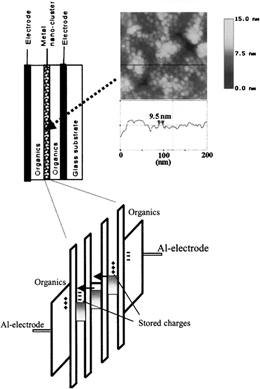無機/有機ナノコンポジットを利用した電気メモリーデバイス
Electrical memory devices based on inorganic/organic nanocomposites.
2012年6月8日 NPG Asia Materials 4, e6 (2012) doi:10.1038/am.2012.32
ナノコンポジット:メモリー開発に取り組む

Tae Whan Kimをはじめとする研究チームは今回、有機材料と無機材料を組み合わせたナノコンポジット材料が、メモリー部品としていかに魅力的かについて概説している。2状態間のスイッチングにより多種多様な構造体が情報記憶に利用され、これまでに揮発性、不揮発性を問わずさまざまなメモリーシステムが誕生している。よく知られた例としては、揮発性ではランダム・アクセス・メモリー(RAM)、不揮発性ではコンピューター・ハードディスクがある。中でも、金属ナノ粒子が埋め込まれたポリマーマトリックスなどの有機-無機ハイブリッドデバイスは、作製が容易で費用効果が高いうえ、機械的柔軟性があり、効率も高い。今後、さらなる研究によって、メモリー機構の理解が深まり、スイッチング速度や再現性を改善する試みがなされていくだろう。こうしたハイブリッド構造体は、次世代ポータブルデバイスの構築に必要なフレキシブル・メモリーの開発に特に有望である。
Nanocomposites: Working on memory
Tae Whan Kim and co-workers review how nanocomposite materials that combine organic and inorganic materials are attractive for use in memory components. A wide variety of structures have been used to store information by switching between two states, making for either volatile or nonvolatile memory systems; well-known examples of both types are random access memory (RAM) and computer hard disks, respectively. Among those, hybrid organic-inorganic devices–such as a polymer matrix in which metal nanoparticles have been incorporated–are easy to make, cost-effective, mechanically flexible, and efficient. Further studies will endeavour to better understand the memories' mechanisms and improve their switching speed and reproducibility. These hybrid structures are particularly promising for the development of flexible memories required to construct the next generation of portable devices.

